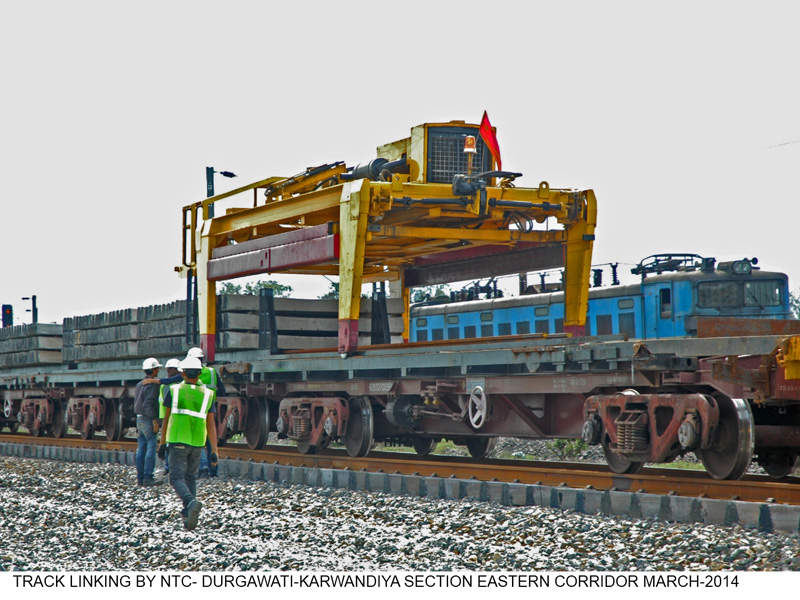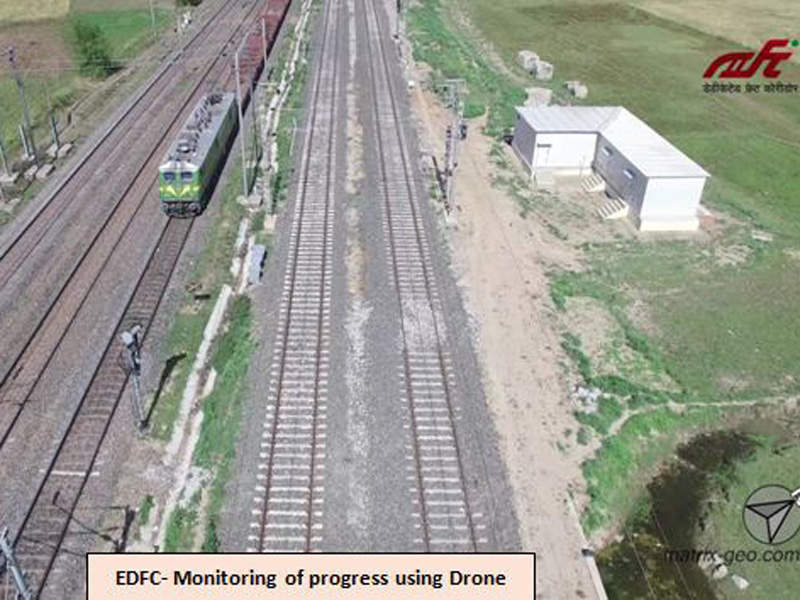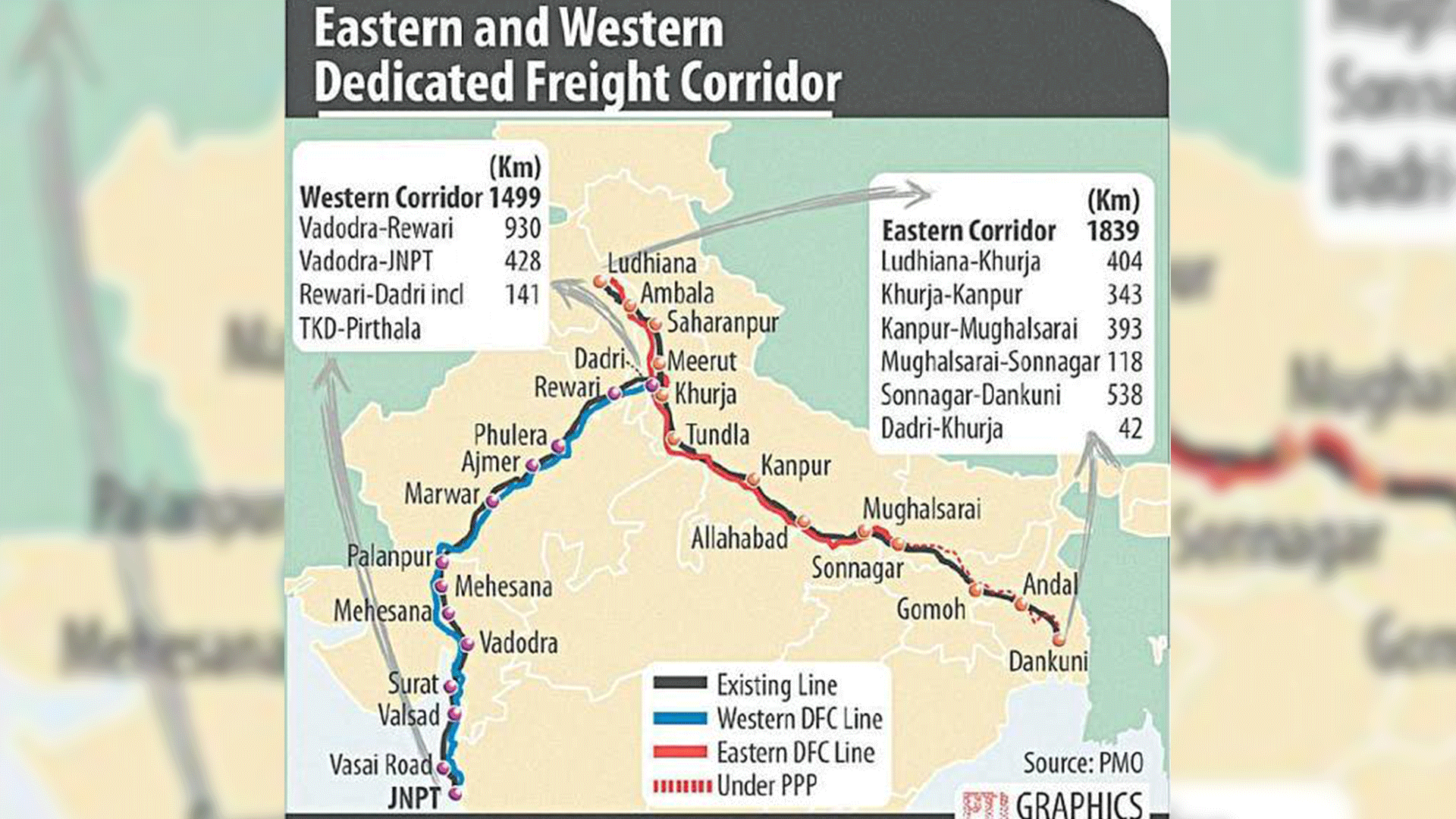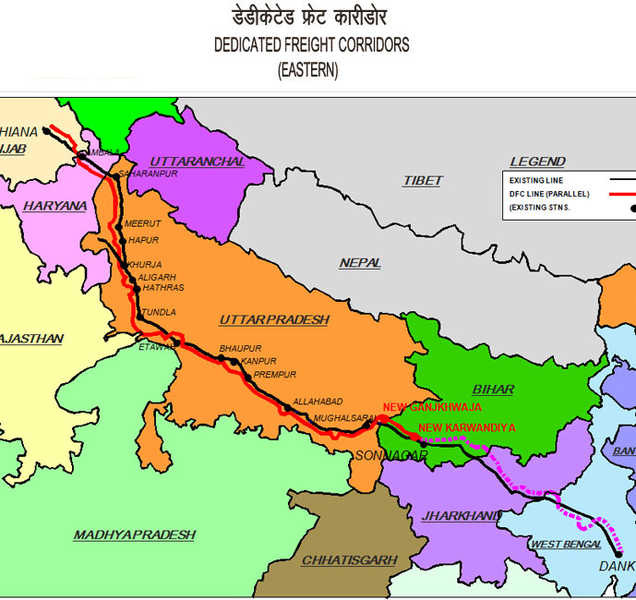What is a Dedicated Freight Corridor (DFC)?
The Indian Railways (IR) being the most significant railway systems in the world has resulted in the suboptimal usage of the track capacity. Transporting on an average 23 million passengers and 2,234 million tonnes daily, IR is looking towards advancements in order to decongest the routes. Borrowing from the system followed in more advanced railway systems like the United States, Australia, China & South Africa, through the DFC project it is looking to have separate tracks for passenger and freight traffic.
Dedicated Freight Corridor (DFC) as proposed is a 194 km-long and fully electrified rail route between New Bandhan & Khurja (Uttar Pradesh). A part of the Eastern wing of the DFC (EDFC) is meant to carry mostly iron & coal to destinations including Mughal Sarai, Tatanagar and Chakardharpur. The central vision behind the introduction of the EDFC was to meet the growing demand for freight on the Eastern Corridor. The eastern corridor, as identified, starts from Dankuni in West Bengal and passes through the states of Jharkhand, Bihar, Uttar Pradesh (UP) and Haryana before finally ending at Ludhiana.

EDFC by March 2020.
The plan of EDFC has been long pending in the country, since its introduction in 2006. However, it is anticipated to be up and working in a section between Delhi & Howrah route in the next six months.
The Wire reported that the Prime Minister Narendra Modi is expected to flag off the first commission of the freight train on the said track. The track which is scheduled to be inaugurated will be solely for the movement of goods between the two stations. This dedicated goods corridor is being looked after, given the cash crunch. The Indian Railways is expecting the said goods related freight service to decongest the existing paths which are ‘over-saturated’. This will also result in the timely running of passenger trains if the routes are organized. Decongestion of the tracks at a time when the Indian Railways is offering 150 trains to the private players will become essential.
The entire stretch of EDFC project involves the construction of a 1,839km-long freight line extending from Ludhiana in the Indian state of Punjab to Kolkata, the capital city of West Bengal. Of the said plan, though only a 200 km long part is becoming operational, it is seen to have an impact on the operations of passenger trains in the section. The present stage of the project is under trial, where rails are being run in the said section with 0 long haul goods trains using the route. The trials itself has resulted in an improvement of punctuality rate of passenger trains in the division, said a senior DFC official.

Will result in decongestion & punctuality of passenger trains:
After a phase-wise implementation of the entire section, it will decongest routes affecting the passenger train punctuality in a positive manner. Despite the passenger trains are bearing losses for the railways, and the freight goods train is making money, the former is always prioritized over the latter. The Union Government authorized the DFC project as a whole in 2006 with granting a budget of Rs. 81,400 crore. For more than 13 years now it has shown no considerable development. It has missed many deadlines for completion for many reasons including procedural wrangling, land acquisition, environment clearances and other related issues.
As planned, the targeted deadline for completion of the project initially was 2016-17. However, with an approaching year-end, it shifted to 2017-2018. Now it has been finally set in March 2020. An official issued a statement saying,
“We are expediting the project and expecting to complete it the next year”,
The construction by the national transporter in the DFC project saw the employment of better and new technology to fasten the project. It is using the latest construction, for the first time though, techniques such as mechanized boring/auguring of mast foundations, erection of electrical poles through machines. Moreover, there have also been repeated visits by senior Railways officials involved with the project to inspect work at the sites to keep a check on the progress.
The entire DFC was planned to be a flagship project of the government, involving the construction of over 3000-km worth track exclusively for goods movement on higher speed. The project was divided into different wings- Western DFC (WDFC) & Eastern DFC (EDFC). The WDFC will comprise of 1,594 km of rail stretch starting from Jawaharlal Nehru Port Trust near Navi Mumbai to Dadri in Uttar Pradesh through Vadodara-Ahmedabad-Palanpur-Phulera-Rewari.

The WDFC is funded by the Japan International Cooperation Agency (JICA), which is also funding the Bullet Train Project in Maharashtra. On the other hand, the E DFC covers 1,856 km from Ludhiana in Punjab to Dankuni, near Kolkata in West Bengal, and will traverse the states of Haryana, Uttar Pradesh, Bihar and Jharkhand. The World Bank is funding the EDFC.
The project has seen the trial stage once before as well when in the WDFC, a trial run on the 192 km route was organized. The route connected Ateli (Haryana) and Phulera (Rajasthan). However, the process was stagnated by a diesel locomotive, as the route electrification was still in the process of being done. Both the wings of the DFC- EDFC & WDFC are to be electrified fully, using the Diesel locos.
Apart from the on-ground results of increased punctuality of passenger trains, the EDFC project is also expected to push up the Indian economy. This project will allow the running of many freight trains in the eastern and the western sectors of the country. The Indian Railways are expecting to make functional the loss where it has lost goods business to the roadways. After the running operation of the EDFC, it is planning to regain the market.
The EDFC project aims for a faster run of freight trains in comparison to the already existing system in the country.
As planned, these freight trains will run with the permissible maximum speed of 100 km per hour. This is expected to take up the average speeds from the current rate of 30 km per hour to about the expected rate 75 km per hour, resulting in the efficient running of trains.

















